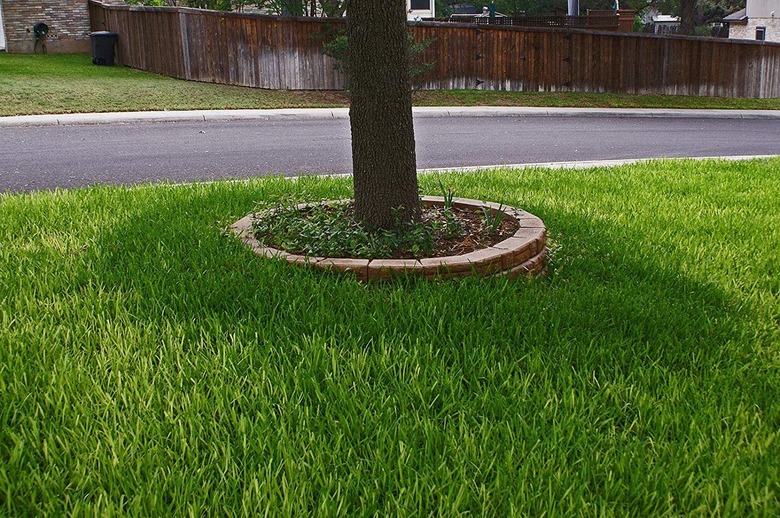Centipede Vs. St. Augustine Grass
We may receive a commission on purchases made from links.
When you are considering centipede grass and St. Augustine grass, it is really an apple-vs.-apple comparison. They are both warm-season grasses that grow best in hot weather, both make for easy-care lawns, and they even resemble each other. There are differences, however, and it's a great idea to get an overview before making a final decision.
Meet Centipede Grass
Meet Centipede Grass
Centipede grass aka centipedegrass (Eremochloa ophiuroides) is one of the best lawn-grass candidates for homeowners in the Southeast. Those living in the band of mild climates extending from the Carolinas to Eastern Texas will find this attractive, heat-tolerant turf grass a low-maintenance choice. Centipede grass grows happily in the slightly acidic soils in that area but does not do well in alkaline soil.
Slow-growing, centipede grass is light green with a coarse texture and pointed tips. It is spread by above ground stolons and tends to have shallow roots. The grass does not accept heavy foot traffic.
With low fertilization and mowing requirements, centipede grass is sometimes called "lazy man's grass." It grows well in sun and accepts shifting shade, but heavy shade will kill it. This grass will not survive cooler winters and is not drought tolerant. It thrives in U.S. Department of Agriculture plant hardiness zones 7 through 9.
Meet St. Augustine Grass
Meet St. Augustine Grass
St. Augustine grass (Stenotaphrum secundatum) is a centipede grass look-alike. Another popular lawn grass in Florida and the Gulf states, it tolerates heat and humidity just as well as centipede grass. Its flat stems and wide, coarse leaves are bright blue-green. They establish quickly and easily to create a dense turf. Since it is salt tolerant, it is an excellent choice for coastal yards in the South.
St. Augustine is a warm-season grass, and it grows best when temperatures rise to between 80 and 100 degrees Fahrenheit. It is not cold tolerant beyond zone 8. It is grown from sod or plugs, which are rooted pieces of sod. Unlike centipede grass, St. Augustine grass cannot be grown from seed, which makes it more expensive to plant. The grass plugs or sod should be planted some three months before the first frost.
Choose Your Warm-Season Turf
Choose Your Warm-Season Turf
Both centipede and St. Augustine are warm-season grasses and good choices for mild climates. They each have advantages and disadvantages that should be considered when choosing between them.
Centipede's primary draw is its extremely low maintenance requirements. If you want to spend a minimal amount of time on keeping up a lawn, this might be the better choice. It requires less water than other grasses and should only be given 1 inch of water when the leaves wilt or the grass color shifts toward gray. Its nitrogen needs are also minimal.
St. Augustine grass is a better bet for lawns with significant shade as well as areas with heavy foot traffic. While centipede grass should be kept at 2 inches in height, St. Augustine can grow to a lush 4 inches. On the other hand, it requires far more fertilizer than centipede grass and deep watering once or twice a week. This grass is also very sensitive to thatch and chinch bugs.
